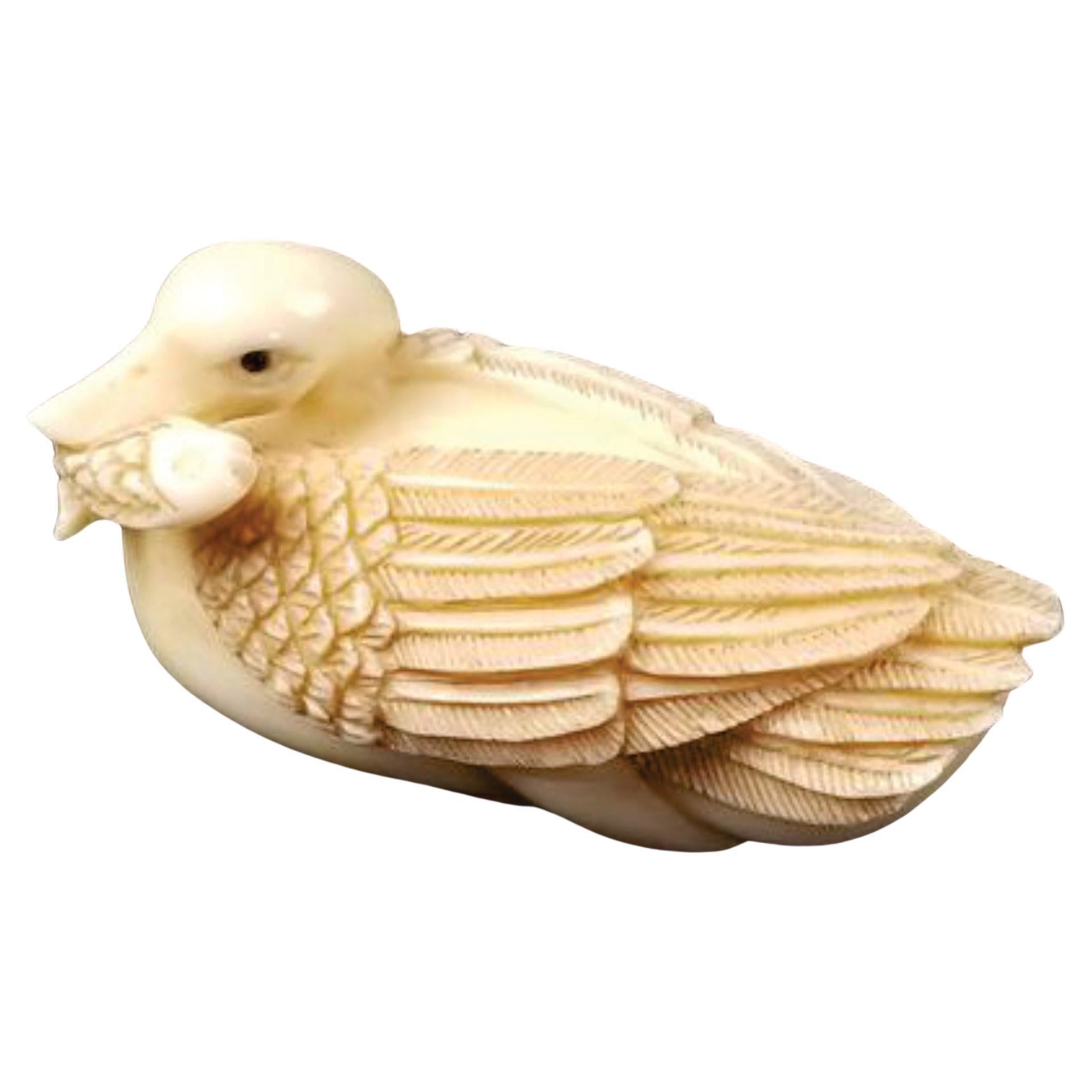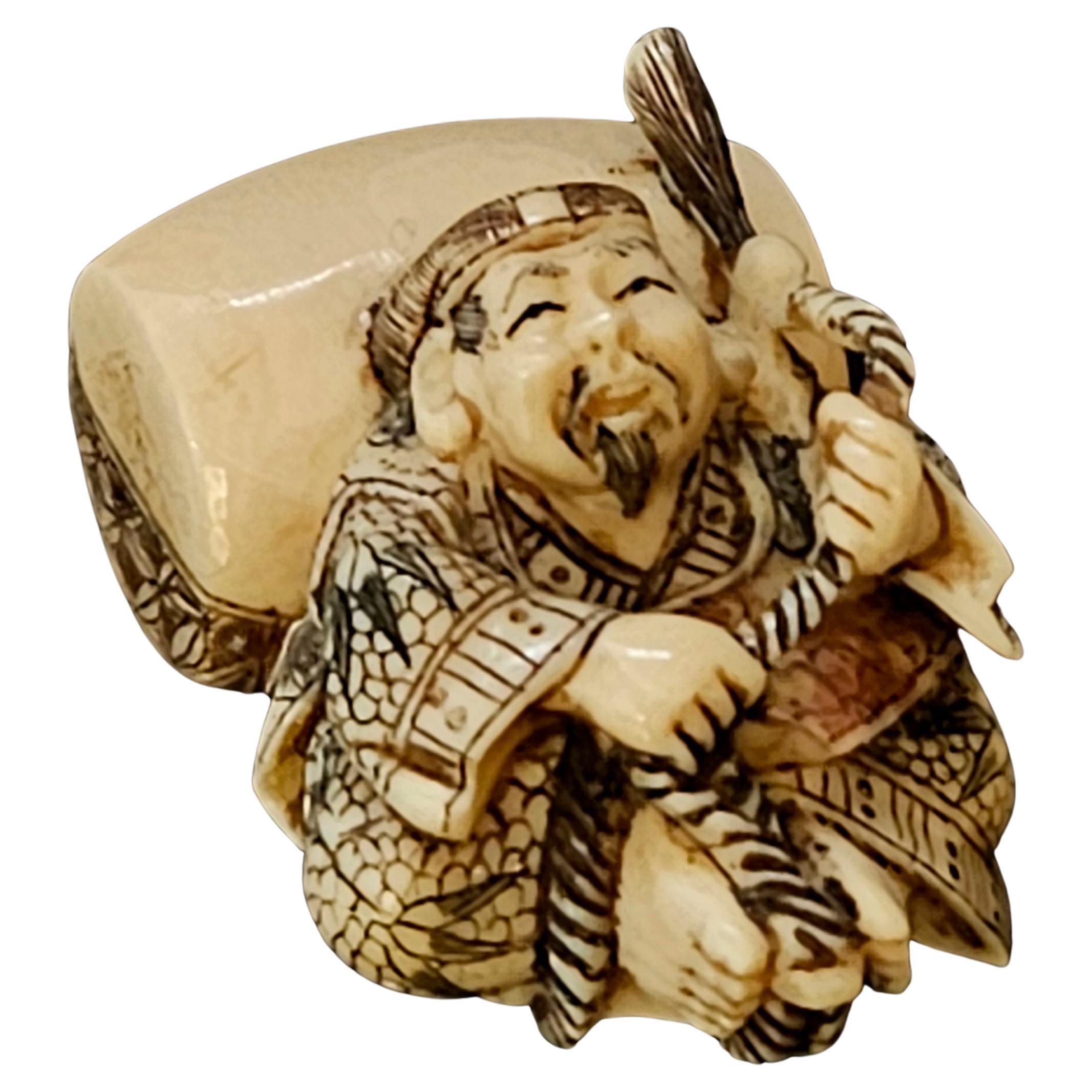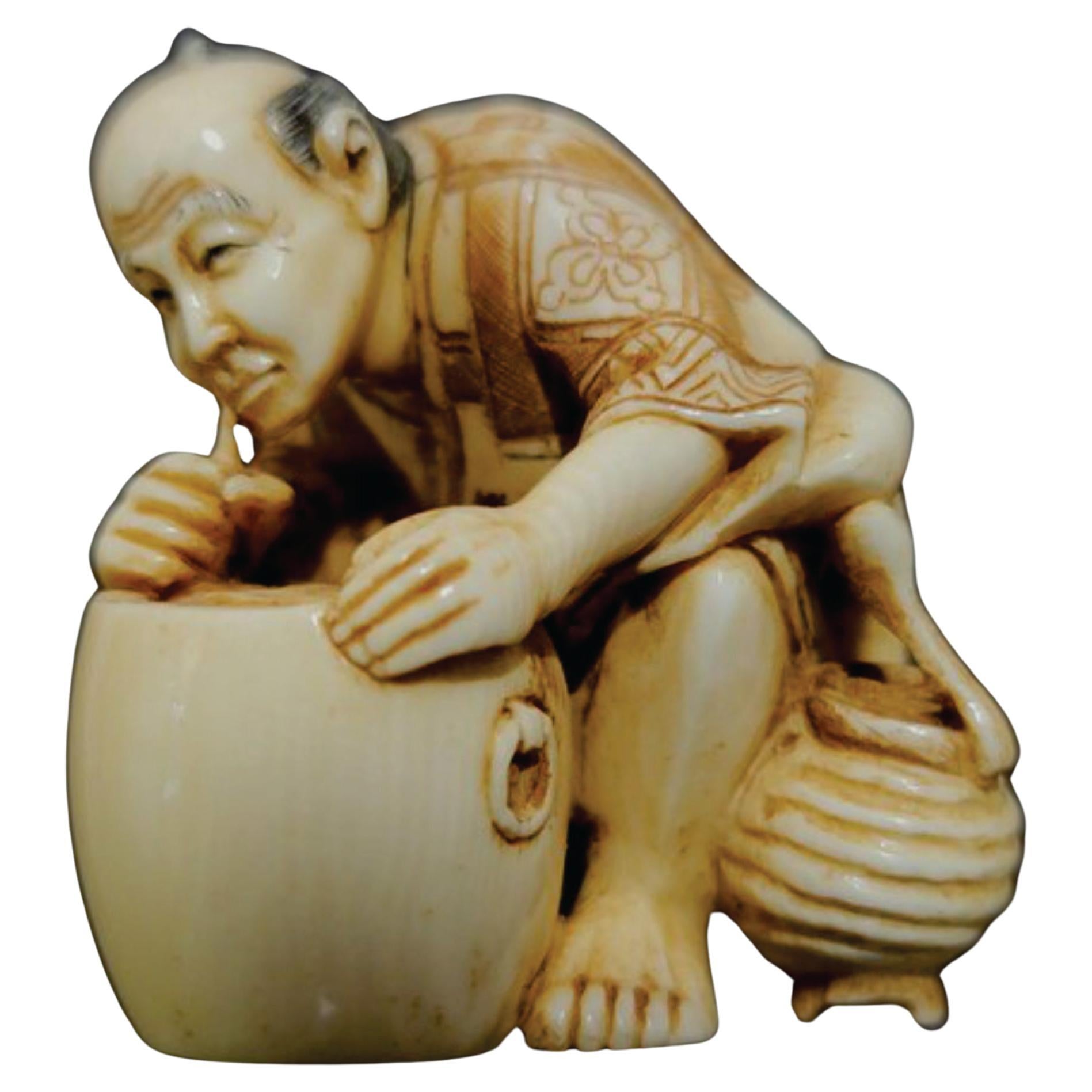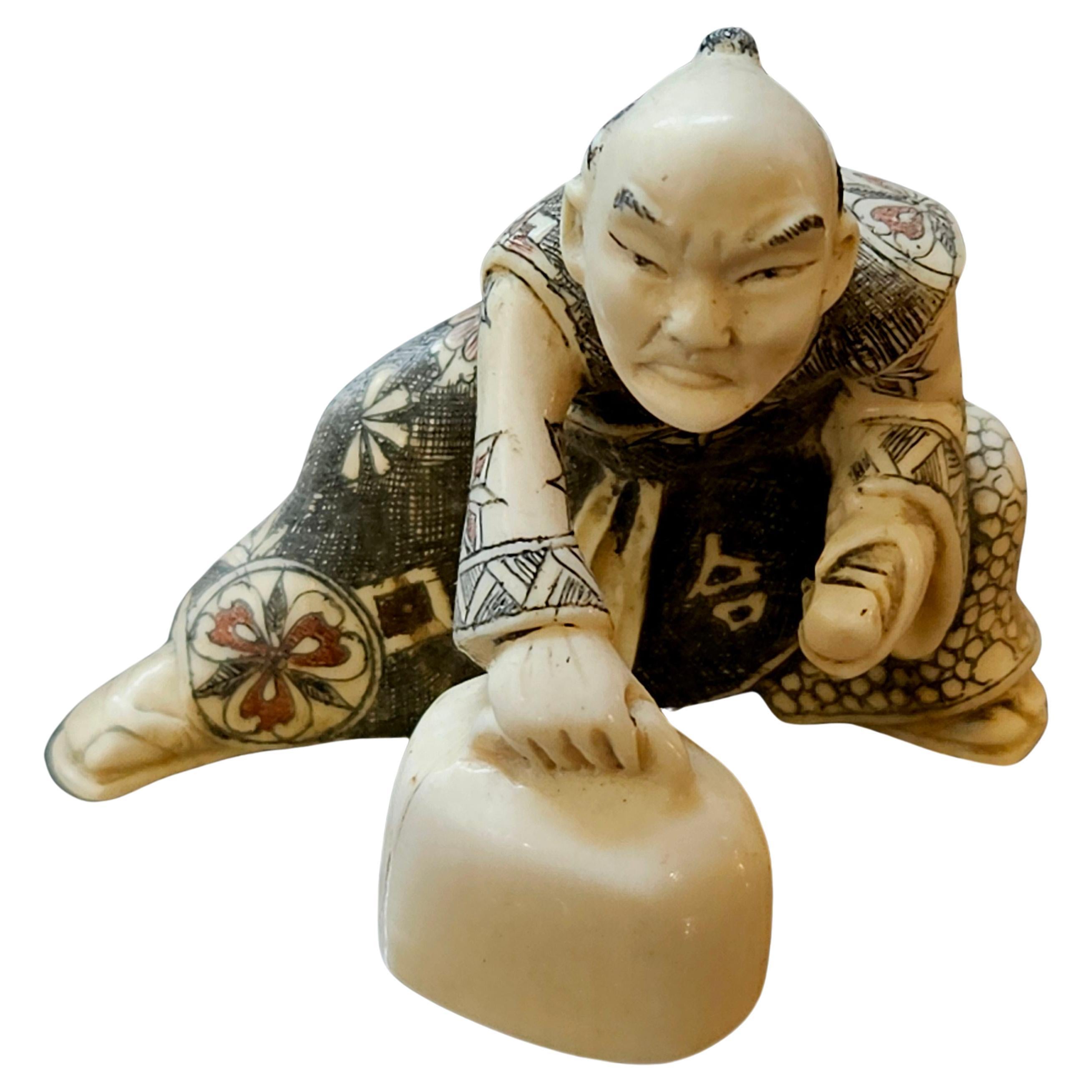Items Similar to Japanese Carved Netsuke Humanoid Dragon-Signed by Yamada Hojitsu (1825–1872)
Want more images or videos?
Request additional images or videos from the seller
Japanese Carved Netsuke Humanoid Dragon-Signed by Yamada Hojitsu (1825–1872)
About the Item
Japanese Carved Netsuke Humanoid Dragon-Signed by Yamada Hojitsu (1825–1872), Ric.NA001
This item is 1.5" wide x 0.75" deep x 2" high in dimension, from the late 19th century, and has extremely detailed carving.
This item is in excellent condition with no damages.
Shipping Note: USA only, no International shipping
The Essence of Netsuke:
Like all art objects of great worth, netsuke distills the essence of a specific time and place. Worn as part of a traditional Japanese man’s ensemble from the 17th century onwards, the netsuke’s purpose was hyper-specific, and its functional simplicity lent artists unlimited freedom to constantly redefine what it could be.
Formally, netsukes have few requirements: they must be small, they must have holes through which to pass a single cord, and they must have no protuberances that could damage one’s kimono. Everything else is left to the carver’s imagination. As such netsuke differs in style, subject, and material as widely as the personalities of their makers, and they are consequently supremely collectible.
Netsuke emerged as a practical solution to dressing in 17th-century Japan. ‘Men’s kimonos didn’t have sewn-up sleeves — they were completely open, front and back, and that meant that the sleeves couldn’t be used as a pocket, as they could in women’s kimonos,’ Goodall explains. To carry things such as tobacco, medicine, or other necessities, men hung stylish inro and other vessels from cords looped under and behind the wide sashes that held their kimonos in place. At the other end of those cords, men fastened small, ornamental objects as counterweights; those objects evolved into netsuke.
The netsuke’s origins are still ‘theoretical’, Goodall says. ‘It’s thought that, with increasing imports from China in the late 17th and early 18th centuries, the toggles that were used on Chinese clothing were imported,’ she explains. Those toggles may have spawned the netsuke.
But the netsuke we know today is a distinctly Japanese art form. ‘As the form developed, and as the netsuke carvers began to compete with each other to come up with new and different ways of handling netsuke, then it became a localized art form that did not relate to anything in China,’ Goodall says. ‘It had completed its evolution by the 19th century.’
Much like jewelry, watches, and handbags today, netsuke were worn to match different occasions and ensembles. Japanese men who could afford them amassed netsuke to diversify their wardrobes.
Still, as Japanese fashion became more influenced by the West, netsuke disappeared from everyday use. Westerners took up the collector’s mantle. ‘In the Meiji period, right after Japan opened to the West in 1854, Americans and Europeans discovered netsuke and immediately started collecting them,’ Goodall says. ‘Westerners were so intrigued by netsuke that carvers continued to make a living by selling them to Westerners.’
- Dimensions:Height: 2 in (5.08 cm)Width: 1.5 in (3.81 cm)Depth: 0.75 in (1.91 cm)
- Materials and Techniques:
- Place of Origin:
- Period:
- Date of Manufacture:19th Century
- Condition:Wear consistent with age and use. Wear consistent with age and use.
- Seller Location:Norton, MA
- Reference Number:1stDibs: LU5848239560082
About the Seller
5.0
Platinum Seller
These expertly vetted sellers are 1stDibs' most experienced sellers and are rated highest by our customers.
Established in 2000
1stDibs seller since 2021
85 sales on 1stDibs
Typical response time: <1 hour
- ShippingRetrieving quote...Ships From: Norton, MA
- Return PolicyA return for this item may be initiated within 3 days of delivery.
More From This SellerView All
- Antique Pair of Japanese Carved Netsukes "Dragon Turtles", Meiji PeriodLocated in Norton, MAAntique Pair of Japanese Carved Netsukes "Dragon Turtles", depicting two turtles with turtle bodies but dragon heads. This item is 1.35" wide x 1.75" deep x 1" high in dimension, fr...Category
Antique 19th Century Japanese Decorative Boxes
MaterialsIvory, Paint
- Japanese Carved Netsuke A Goose Biting a Fish-Signed by Tomotada, MeijiLocated in Norton, MANetsuke Japanese Hand-Carved Mixed Material Figure, A Goose Biting a Fish-Signed by Tomotada from the Meiji period. Ric.NA007 This item is 2" wide x 1" deep x 0.75" high in dimensio...Category
Antique 19th Century Japanese Decorative Boxes
MaterialsIvory, Paint
- Japanese Carved Netsuke Polychrome Decorated Figur, Signed by Matsuyoshi, MeijiLocated in Norton, MANetsuke Japanese Hand-Carved Polychrome Decorated Figure, Signed by Matsuyoshi, from the Meiji period. Ric.NA003 A truly hand-carved mixed material figure, A Wise Man Holding a Rope,...Category
Antique 19th Century Japanese Decorative Boxes
MaterialsIvory, Paint
- Japanese Carved Netsuke Polychrome Decorated Figure, Signed by Yoshitomo, MeijiLocated in Norton, MANetsuke Japanese Hand-Carved Polychrome Decorated Figure, Signed by Yoshitomo from the Meiji period. Ric.NA004 A truly hand-carved ivory figure, An old man holding a straw and soaki...Category
Antique 19th Century Japanese Decorative Boxes
MaterialsIvory, Paint
- Japanese Carved Netsuke Polychrome Decorated Figure, Signed, Meiji PeriodLocated in Norton, MANetsuke Japanese Hand-Carved Polychrome Decorated Figure, Signed on the bottom from the Meiji period. A truly hand-carved ivory figure, A man is lifting a weight. It looks like he ...Category
Antique 19th Century Japanese Decorative Boxes
MaterialsIvory, Paint
- Japanese Carved Netsuke Polychrome Figure "Sumo" Signed, Meiji PeriodLocated in Norton, MANetsuke Japanese Hand-Carved Polychrome Decorated Figure "Sumo", depicting a strongman holding a big rope and pulling something, signed on the bottom from the Meiji period. This it...Category
Antique 19th Century Japanese Decorative Boxes
MaterialsIvory, Paint
You May Also Like
- Box Wood Netsuke Turtle Mushroom Japanese Japan Signed, 20th CenturyLocated in Amsterdam, Noord HollandLovely and very detailed piece. Signed. Japan 19th or 20th century. Additional information: Material: Porcelain & Pottery Type: Incense Burners, Koro Region of Origin: Japan Period:...Category
20th Century Japanese Decorative Boxes
MaterialsPorcelain
- Rare Japanese Sumi-E Lacquer Inro Yamada Jokasai Edo PeriodLocated in Atlanta, GAA three-case lacquered Inro by Yamada Family circa 18th-19th century Edo period. The inro with slight rounded form is of Kano style and vividly depicts a dragon slithering among the ink clouds on a gold background. Sumi-e togidashi (ink togidashi) technique, in combination with Hiramaki-e, were employed to create the dreamy ambience of this piece. The dragon has a painterly appearance inspired by Chinese ink painting that was often seen on the Japanese folding screens. The back of the Inro was sparsely decorated with the shifting patterns of the darkening clouds with an emphasis on the space intentionally left empty. Jokasai was signed to the base. On the front of the inro there is another miniature signature Hakugyoku Hogen, which is one of names used by Kano Michinobu (1730-1790). The dragon is evidently one of his designs (see reference below). Established by a member of Yamada family in the 17th century, the clan was one of the most prominent lacquer artisanal family for the next 200 years until the end of Edo period in the 19th century. Most members signed their work simply with Jokasai making the identification of the individual artists somewhat impossible. The current Inro on offer, compared to many other pieces by Jokasai, has an uncommon Kano style done in Sumi-e togidashi. Another unusual feature of this piece is that the interiors of the inro was decorated with an interesting gold mosaic inlays (kirigane) on a dark lacquer background, giving it a jewel like quality. For another Inro by Jokasai of a similar style using Sumi-e togidashi but depicts a tiger, see Wrangham collection, no.353, which was offered for sale as lot 256 in Bonham's London Auction: The Edward Wrangham Collection of Japanese Art Part I. 9 Nov 2010. For an ink scroll...Category
Antique 18th Century Japanese Japonisme Lacquer
MaterialsWood, Lacquer
- Antique Large Rectangular Japanese Silver Cigar Box Decorated with DragonsLocated in Braintree, GBAntique Japanese silver cigar box Made in Japan, early 20th century, Circa 1900. Maker (Unidentified) Fully hallmarked. Please note: Interior has been professionally restored. Dim...Category
Early 20th Century Japanese Meiji Decorative Boxes
MaterialsSilver
- Silver Sugar box, Vienna 1867-1872Located in Delft, NLSilver Sugar box, Vienna 1867-1872 An Austrian-Hungary silver sugar box with hinged lid. On the lid a rose with leaves as knob. A rectangular box with beautiful round scalloped body...Category
Antique 19th Century Austrian Tableware
MaterialsSilver
- Antique Chinese Carved Cinnabar & Enamelled Box with Imperial Dragon TopLocated in Hamilton, OntarioThis antique decorative box is unsigned, but presumed to have originated from China, and date to approximately 1920 and done in a period Chinese...Category
Early 20th Century Chinese Chinese Export Decorative Boxes
MaterialsBrass
- Japanese Carved Kamakura Lacquer Box with Botanical Design by Tamerou OnoLocated in Prahran, VictoriaA vintage Japanese Tsuzuri bako, writing box. with an unusual, deeply carved relief of Japanese sarcandra glabra, a woody herbal sub-shrub native to Asia with deep green glossy leave...Category
Mid-20th Century Japanese Lacquer
MaterialsWood
Recently Viewed
View AllMore Ways To Browse
Chinese Ivory Carving
Dragon Jewellery Box
Dragon Mantle
Carved Ivory Dragon
Chinese Dragon Kimono
Antique Medicine Box
Japanese Ivory Netsukes
Antique West End Watch
Chinese Netsuke
Antique American Wardrobe
Mens Pocket Watch Antique
Man Antique Pocket Watch
Chinese Clothing 18th Century
Mens Jewelry Boxes
Chinese European Subject
Small Kimono
Dressing Up Box
Mens Fashion Watches





